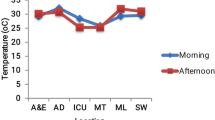Abstract
As part of the overall management of a Hospital, the Hygiene Unit has specific tasks including the improvement in the levels of hospital safety by air quality monitoring in hospital environments to control the sources of infection and assessing the healthiness of hospital facilities. Operating theaters (OTs) and cleanrooms air quality control can represent a focal point considering that environmental contamination depends on not only factors such as characteristics and level of maintenance of Heating, Ventilation and Air Conditioning systems (HVAC), but it also depends on the number of people present, their behavioral habits, sanitation and disinfection procedures adopted. Several studies demonstrate a high variability in microbial air contamination in different OTs with similar HVAC, suggesting the need for achieving strict control over the factors affecting air quality. The control of air contamination, as an indicator of the quality care provided, therefore sets precise objectives, accuracy from a scientific point of view including planning, analysis and interpretation of results to propose corrective actions. However, there are no generally accepted standards for sampling nor threshold values on microbial air contamination. Aerobiology skills can improve the approach to involved issues. The monitoring plan of air quality assessment at the Parma University Hospital, by the Laboratory of Aerobiology, involves approximately 80 environments equipped with turbulent or mixed air flow. This paper describes the practical approach to air contamination control of the Hospital Hygiene Department at the Parma University Hospital as an example of how Health Departments can improve safety standards for patients and operators.
Similar content being viewed by others
References
AFNOR NORMALISATION (2013). NFS 90351—Établissements de santé.
Agodi, A., Auxilia, F., Barchitta, M., Cristina, M. L., D’Alessandro, D., Mura, I., et al. (2015). Operating theatre ventilation systems and microbial air contamination in total joint replacement surgery: Results of the GISIO-ISChIA study. Journal Hospital Infection,90, 213–219.
Buttazzi, R., Ricciardi, A., Gagliotti, C., & Moro, M. L. (2018). Sorveglianza delle infezioni del sito chirurgico in Italia Interventi ortopedici anno 2015, Interventi non ortopedici anno 2016 Sistema nazionale di sorveglianza delle infezioni del sito chirurgico. file:///C:/Users/utente/Downloads/report%20snich%202016%20(1).pdf Access January 30th 2018, pp. 1–61.
Eickhoff, T. C. (1970). Microbiological sampling. Hospitals,44, 86–87.
Eickhoff, T. C. (1994). Airborne nosocomial infection: A contemporary perspective. Infection Control Hospital Epidemiology,15(10), 663–672.
EU Guidelines to Good Manufacturing Practice Annex 1, Update 2008.
Lidwell, O. M., Lowbury, E. J., Whyte, W., Blowers, R., Stanley, S. J., & Lowe, D. (1982). Effect of ultraclean air in operating rooms on deep sepsis in the joint after total hip or knee replacement: A randomised study. British Medical Journal,285(6334), 10–14.
National Health Service. (1994). HTM 2025 ventilation in healthcare premises. Operational management.
National Health Service. (2007). Specialised ventilation for healthcare premises.
National Institute for Occupational Safety and Prevention, ISPESL. (2009). Linee guida sugli standard di sicurezza e di igiene del lavoro nel reparto operatorio Parte 2: Valutazione e interpretazione dei dati di biocontaminazione.
Pasquarella, C., Vitali, P., Saccani, E., Manotti, P., Boccuni, C., Ugolotti, M., et al. (2012). Microbial air monitoring in operating theatres: Experience at the University Hospital of Parma. Journal Hospital Infection,81(1), 50–57.
SF2H. Qualité de l’air au bloc opératoire et autres secteurs interventionnels. Hygiène (2015).
Surveillance microbiologique de l’environnement dans les établissements de santé. Guide de bonnes pratiques—CCLIN Sud-Ouest—2016.
UNI 11425:2011—Impianto di ventilazione e condizionamento a contaminazione controllata (VCCC) per il blocco operatorio—Progettazione, installazione, messa in marcia, qualifica, gestione e manutenzione.
UNI EN ISO 14644:2001 Camere bianche ed ambienti associati controllati—Classificazione della pulizia dell’aria.
UNI EN ISO 14644-1:2016—Camere bianche ed ambienti controllati associati—Parte 1: Classificazione della pulizia dell’aria mediante concentrazione particellare.
UNI EN ISO 14698-1:2004 Camere bianche ed ambienti associati controllati—Controllo della biocontaminazione—Parte 1: Principi generali e metodi.
UNI EN ISO 14698-2:2004 Camere bianche ed ambienti associati controllati—Controllo della biocontaminazione.
WHO (2016). Global guidelines on the prevention of surgical site infection, pp. 1–184.
Whyte, W., Hodgson, R., & Tinkler, J. (1982). The importance of airborne bacterial contamination of wounds. Journal Hospital Infection,3, 123–135.
Acknowledgement
The authors are grateful to Mrs. Rosslynne Milburn for her linguistic advice.
Author information
Authors and Affiliations
Corresponding author
Rights and permissions
About this article
Cite this article
Albertini, R., Colucci, M.E., Turchi, S. et al. The management of air contamination control in operating theaters: the experience of the Parma University Hospital (IT). Aerobiologia 36, 119–123 (2020). https://doi.org/10.1007/s10453-019-09572-4
Received:
Accepted:
Published:
Issue Date:
DOI: https://doi.org/10.1007/s10453-019-09572-4




